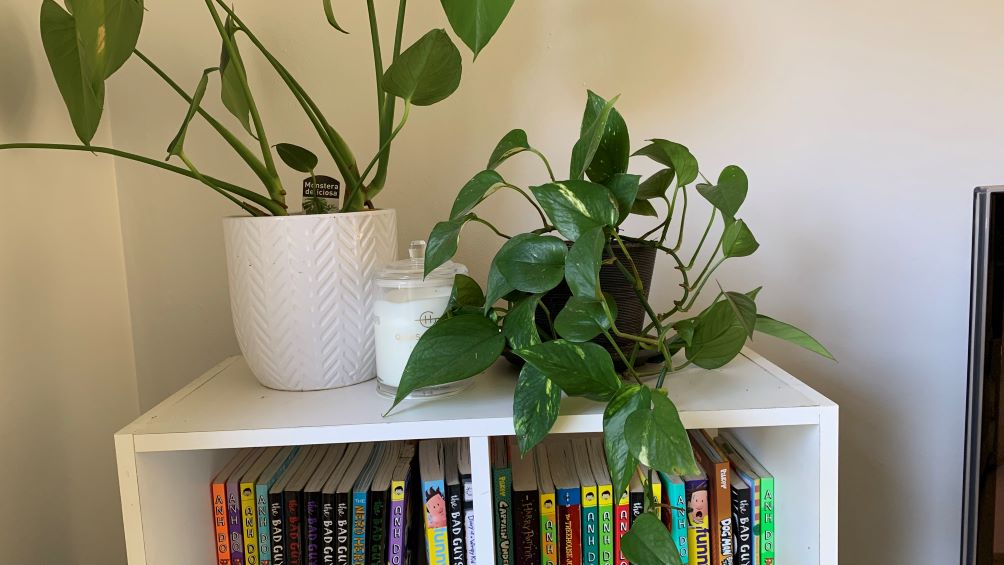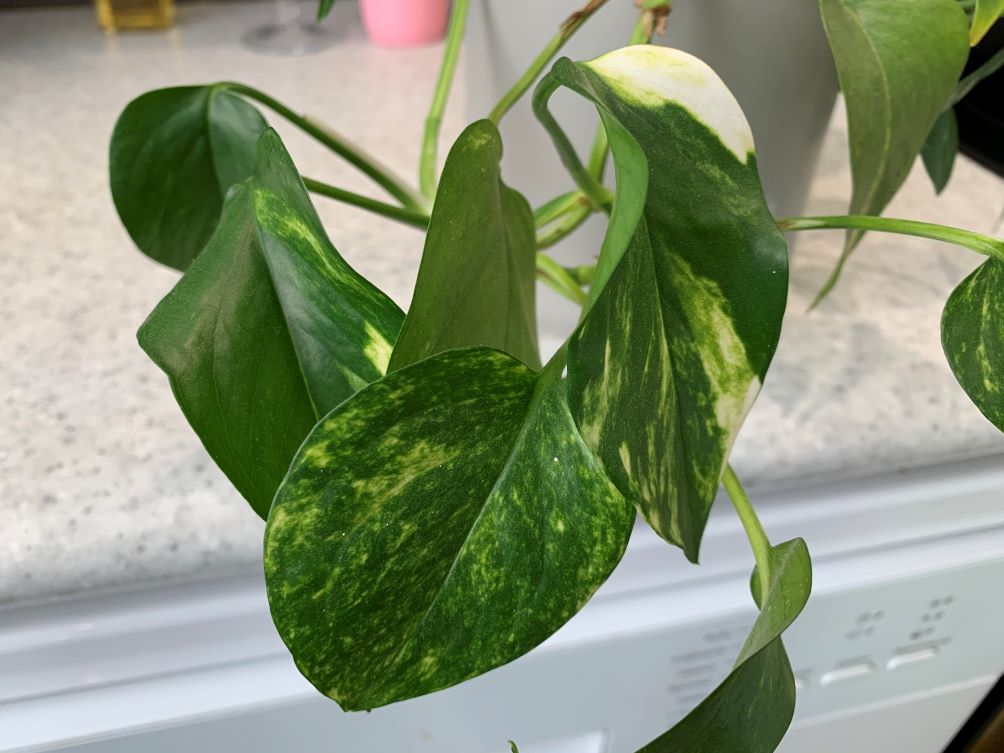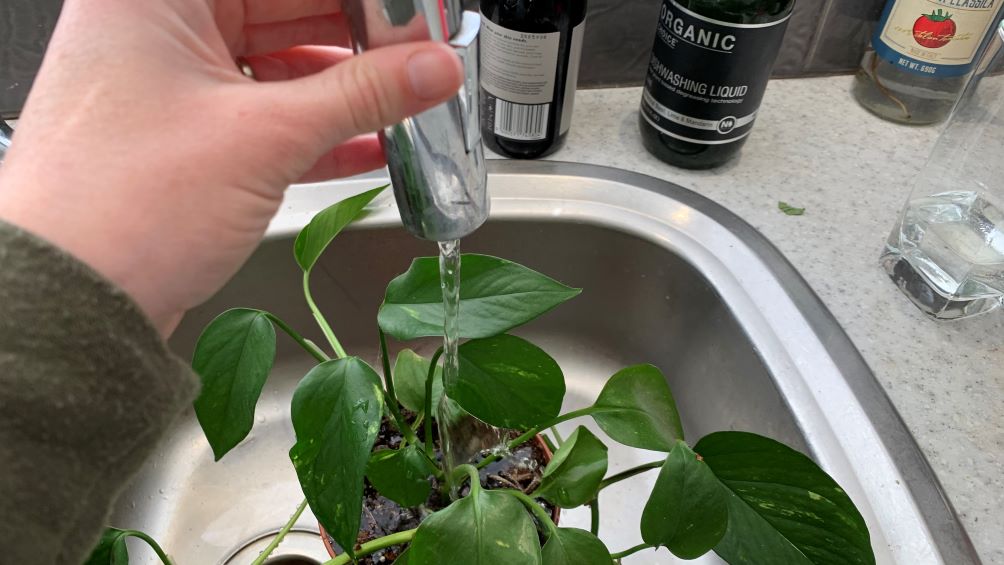Pothos can suffer from root rot if their roots and soil stay wet for too long. Look out for black or dropping leaves, mold on the surface of the soil or black root sticking out the bottom of the pot. Slow down your watering schedule and allow the excess water to drain from the pot before placing it back on a pot tray.
Pothos root rot is common and can kill a pothos plant over a period of months. This article will explore the causes of root rot, how to identify it in your own plants and easy fixes.

The cause of Pothos root rot
Root rot in pothos grown inside or outside is due to excess water that sits around the root system. The extra water will cause the root to turn brown, mushy and rot and the plant will not be able to absorb the nutrients it needs to survive.
Pothos with root rot can show a variety of symptoms including drooping leaves, yellowing or black leaves, dark roots, mold on the surface of the soil and slow growth.
This article will explore the 6 signs to look out for to detect pothos root rot and easy fixes to solve this problem.
Ways to identify pothos root rot
Here are the top things to look out for if to identify root rot in pothos.
1. Wet soil
Pothos root rot is most commonly caused by overwatering. Check your pothos to see if the soil looks damp on top. Too much water will cause the roots to go soggy and rot off in the bottom of the pot.
2. Overwatering
Watering a pothos plant everyday is not necessary so if you are doing this stop and only water once the soil is dry 1 inch below. You can use your finger or a moisture detector to see if the plant needs water.
3. Poor pot drainage
Another cause of overly wet soil is poor pot drainage. Indoor pots without holes should not be used to plant your pothos in directly. This is because water will be trapped in the bottom of the pot where the root system is.
The roots sitting in water are more likely to stay wet and eventually rot.

4. The tray is full of water
Indoor or outdoor pothos plants that are sitting on a tray that catch the water are more prone to rot. This tray can fill up when it rains or when the excess water from your watering can drains down.
Water that sits in these trays will sit on the roots causing them to eventually rot as the water is reabsorbed into the soil.
5. White mold
Another sign that a pothos plant might be suffering from root rot is white mold. Mold that sits on the surface of the soil that looks like a light, white snow blanket is a sign that the plant is getting too much water and the soil is staying wet for a long time.
Soil that stays wet can cause root rot as the root are exposed to moisture over a long period of time.
6. Dark or black roots
Root rot will be easy to spot if you see dark or black roots coming out the bottom of your pothos pot. Dark brown, black, soggy or hanging roots are all sign of root rot as the moisture has gotten into the roots.
Check any roots that might be popping out of the drainage holes of your pot, and if you have decided to repot, have a look around the edges to see if the roots look dark, black and damaged.
7. Drooping, yellow or black leaves
Pothos that are suffering from yellowing or black leaves are showing signs of overwatering and possible root rot. Yellowing on the leaves will occur when the nutrients are washed away and the plant cannot get enough. Nitrogen in particular can be washed out of the soil with lot of water causing yellowing.
Black leaf spots can also occur with overwatering as the plant leaf matter cannot survive. These dying leaves are a clear sign there is too much water in the pot which could lead to root rot.

8. Slow growth
Another indicator that your pothos might be suffering from root rot is slow growth. While pothos growth will slow down in the cooler months, if your plant looks like it is not growing at all when it warms up in spring there might be a problem with the roots.
Before the pothos suffers from extreme root rot, the growth rate will slow as the plant cannot absorb the nutrient it needs to grow and thrive.
How to fix pothos root rot
Here are the easy step to follow to fix pothos root rot and prevent it from happening again.
Repot into new potting oil
Repotting your pothos into new potting soil is a great way to give them back the nutrients they need and soil that I not soggy.
Take the plant out of the pot and remove some of the excess soil. If you notice damaged roots, these can be trimmed using sharp secateurs.
If you are planting the pothos back into the same pot, wash the pot first.
Check out my previous article here on how to disinfect plant pots without using bleach for an easy way to do this.
Use new, good quality potting soil to re-pot your pothos giving the roots a chance to recover and regrow.
Water the plant over the sink and allow it to drain
The watering method you use for pothos in pots is really important to prevent root rot. This is as easy as taking the inner pothos pot out of the outer pot, placing it in a sink and watering gently.
Allow the pot to drain down the sink for around 10 minutes before putting it back into the outer pot. This will allow the extra water to drain out preventing the roots from sitting in water for too long and rotting.
Remember to clean out your sink well after watering any indoor plants inside.

Place it in a sunnier position near a window
Another way to prevent root rot in pothos once you have slowed down your watering schedule and repotted it is to place the pot in a sunnier position in your home. Place pothos near a bright window to allow the soil to dry out quicker.
This will allow the soil to dry out and prevent root rot.
Test the soil before watering
Your watering schedule matters a lot in the prevention of root rot in pothos. Check the moisture level of the soil before adding more to the pot with your watering can or faucet. Stick your finger into the soil or use a moisture monitor to check the levels below the soil.
Only add water once the soil feels dry 1 inch down and allow it to drain well before placing it back inside the inner pot or on a pot tray.
Pothos root rot guide | Summary
Pothos root rot can happen when too much water is given to the plant. Pothos are a hardy plant so they are very forgiving once the problem is identified and the watering schedule adjusted. Many indoor plants get so much love and water that they can end up with this problem.
Check for the 8 signs above and repot your pothos if you suspect the soil is wet, soggy and lacking nutrients due to overwatering.
Pothos can recover from this problem and regrow new roots to replace the old.
Happy planting
I am an accredited practicing dietitian, experienced gardener and a dedicated cook. I love writing and sharing my experience so you can learn from my successes and mistakes.
